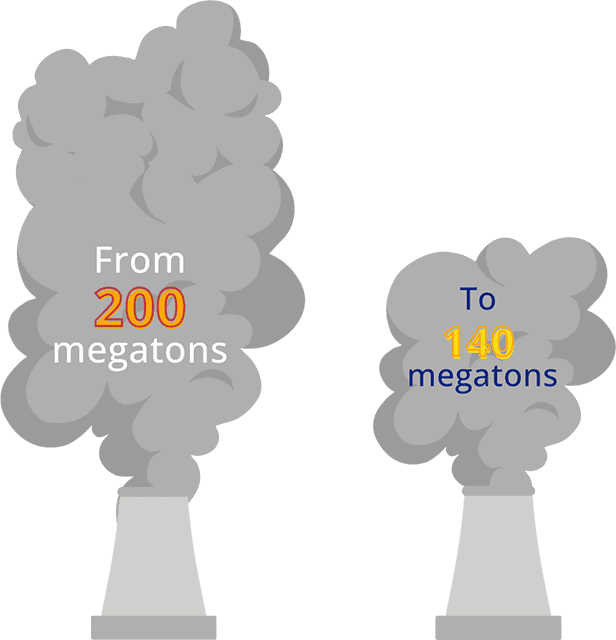
We need energy to survive, live more comfortably and #energisemzansi. Energy powers our daily lives, but with increased energy consumption comes a rise in CO2 emissions. These emissions harm the environment and can negatively impact you and your fellow South Africans.
Over the past 50–70 years, global CO2 emissions have surged as industrialisation, fueled by the burning of fossil fuels, transformed economies worldwide. This activity was good for economic growth but has created a global blanket of greenhouse gases that are scientifically proven to increase our planet’s temperature. Rising global temperatures are causing increased climate risk, as seen in the increased frequency of droughts, floods and other natural disasters. The situation is forecasted to worsen significantly if we don’t act swiftly to decarbonise our planet.
The Paris Agreement, a global pact on climate change, is committed keeping global warming below 1,5°C and South Africa is a signatory to that commitment. This includes you and all other South Africans in making the effort to control and/or reduce these emissions.

Increase in number of hot days and heat waves, which are responsible for heat-related illness and make it more difficult to work.

Extreme weather events that impact crop yields and reduce the productivity of grasslands for grazing livestock and water for fisheries.

Changes in rainfall resulting in more frequent and more severe storms which can cause flooding and landslides, destroying homes and property.

Water scarcity is increasing in several regions. Droughts limits availability of water and can lead to destructive sandstorms.

Floods can sweep away informal settlements, destroying homes & livelihoods. Heat can make it difficult to work outdoor jobs (e.g., farming) impacting livelihoods.

Increased temperatures results in more heat-related illness, such as malaria and other vector-borne diseases as well as heat stress and heat stroke.
Reducing carbon emissions is a crucial part of South Africa’s energy future.
For South Africans, it’s a mountain to climb as South Africa is one of the most carbon-intensive economies in the world, and is the 13th largest emitter accounting for more than 40% of Africa’s emissions. Although Africa only accounts for 4% of global emissions, South Africa plays a critical role in the global decarbonisation race and have introduced laws to enforce this.
The 2016 Paris Agreement, an international treaty that forms part of the United Nations Framework Convention on Climate Change (UNFCCC) and of which South African is a signatory, aims to limit global warming to 1.5°C by the end of this century thus requiring countries to bring down their emissions to acceptable levels. These are measured as Nationally Determined Contributions, or NDCs.
The entire world is not on track for this target and scientists currently forecast that we are likely to see a 2.3 ºC, which will cause catastrophic climate events.
Our exports are increasingly under pressure as trade partners introduce policies like the EU’s Carbon Border Adjustment Mechanisms (CBAM), which taxes carbon emissions in imported goods. An estimated R50 billion worth of South Africa’s exports are at immediate risk, with this figure expected to grow. Industries such as iron, steel, and aluminium are especially vulnerable, highlighting the potential economic impact and the crucial role we all play in addressing this challenge.
As a country, we’ve committed to an NDC Range of 350 to 420 megatons a year. To reach that, the power sector – which is the biggest contributor to carbon emissions – will have to reduce emissions from 200 megatons a year, to 140 megatons. We’re also committed to net zero emissions by 2050.

Given that over 80% of South Africa’s electricity comes from coal, meeting the country’s NDC target for 2030 means gradually switching from coal to renewable energy sources like wind and solar, or using energy sources with less emissions than coal, like natural gas.

We don't have to close down all coal power stations, though. Even if the Energy Availability Factor from coal power stations is at 60%, South Africa will be able to meet its NDC targets. So there won’t need to be a trade-off between energy security and climate.
Unfortunately, yes! Addressing carbon emissions in our energy transition will require significant investment in new infrastructure, technologies, and job reskilling.
According to some estimates, reaching our NDC target could increase the cost of the energy system by around 10%.

We’re going to need international support to deal with that – as well to ensure a Just Transition by managing the socioeconomic impact.
The objective of the Just Energy Transition is to shift from a fossil fuel based energy system to a sustainable, low-carbon one while addressing social, economic, and environmental challenges. It aims to ensure that the transition is fair and inclusive, prioritizing job creation, community development, and support for those most affected, such as workers in traditional energy sectors and vulnerable communities. The goal is to balance sustainability with equity, leaving no one behind.

The balancing act between ensuring energy security and avoiding further damage to the planet needs to be carefully managed.
You can join us in identifying ways to navigate these critical areas that South Africa must align on:
#EnergiseMzansi
Let’s work together to cut carbon emissions

Physical Address:
12 Desmond Street,
Kramerville, 2148, South Africa
Enquiries:
Email: info@energycouncil.org.za
© 2025 Energy Council of South Africa.
All rights reserved | Privacy Policy | Fraud and Unethical Conduct
| Cookie | Duration | Description |
|---|---|---|
| cookielawinfo-checkbox-analytics | 11 months | This cookie is set by GDPR Cookie Consent plugin. The cookie is used to store the user consent for the cookies in the category "Analytics". |
| cookielawinfo-checkbox-functional | 11 months | The cookie is set by GDPR cookie consent to record the user consent for the cookies in the category "Functional". |
| cookielawinfo-checkbox-necessary | 11 months | This cookie is set by GDPR Cookie Consent plugin. The cookies is used to store the user consent for the cookies in the category "Necessary". |
| cookielawinfo-checkbox-others | 11 months | This cookie is set by GDPR Cookie Consent plugin. The cookie is used to store the user consent for the cookies in the category "Other. |
| cookielawinfo-checkbox-performance | 11 months | This cookie is set by GDPR Cookie Consent plugin. The cookie is used to store the user consent for the cookies in the category "Performance". |
| viewed_cookie_policy | 11 months | The cookie is set by the GDPR Cookie Consent plugin and is used to store whether or not user has consented to the use of cookies. It does not store any personal data. |
A Power Purchase Agreement (PPA) is a long-term contract between a buyer and a supplier of electricity that defines the terms of the agreement.
Multi-market system – a hybrid market model designed to accommodate various defined transactions (market transactions, physical bilateral transactions and regulated transactions).
Scheduling supply to meet current demand for electricity
Electricity storage encompasses all technologies that can consume electricity (e.g., charge in times of oversupply) and return it later (e.g., discharge in times of undersupply).
The capacity factor is the ratio of the actual electrical energy output over a certain period of time to the maximum possible output if the power source was operating at full capacity all the time. Essentially, it illustrates the efficiency and dependability of an energy source.
A transmission grid is an interconnected network of electrical transmission lines that moves electricity from power plants to distribution systems and end users
Variable renewable energy (VRE) or intermittent renewable energy sources (IRES) are renewable energy sources that are not adjustable due to their fluctuating nature, such as wind power and solar power
Capital costs are fixed, one-time expenses incurred on the purchase of equipment used in the production of goods
The cost added by producing one additional unit of a product or service.
Renewable energy refers to energy generated from a source that is not depleted when used
Liquefied natural gas (LNG) is natural gas that has been cooled down to liquid form for ease and safety of non-pressurized storage or transport.
Republic of Mozambique Pipeline Investments Company
A petajoule (PJ) is a unit of energy measurement that is equal to one million billion joules (10 to the power 15). It can also be expressed as 278 gigawatt hours. One petajoule is equal to 31.60 million cubic meters of natural gas.
Dispatchable generation refers to sources of electricity that can be programmed on demand at the request of power grid operators, according to market needs. Dispatchable generators may adjust their power output according to an order.
Domestic gas is natural gas found underground within a county’s borders
Energy Availability Factor (EAF) = measure of generation performance, electricity available to be generated. EAF is the difference between the maximum availability and all unavailabilities expressed as a percentage
Particulates are microscopic particles of solid or liquid matter suspended in the air. Sources of particulate matter can be natural or anthropogenic. They have impacts on climate and precipitation that adversely affect human health, in ways additional to direct inhalation.
Nitric oxide (NO) and nitrogen dioxide (NO2) are two gases whose molecules are made of nitrogen and oxygen atoms. These nitrogen oxides contribute to the problem of air pollution, playing roles in the formation of both smog and acid rain. They are released into Earth’s atmosphere by both natural and human-generated sources.
Sulfur oxides are a group of molecules made of sulfur and oxygen atoms, such as sulfur dioxide (SO2) and sulfur trioxide (SO3). Sulfur oxides are pollutants that contribute to the formation of acid rain, as well as particulate pollution. Some are released into Earth’s atmosphere by natural sources, but most are the result of human activities.
Net Zero means cutting carbon emissions to a small amount of residual emissions that can be absorbed and durably stored by nature and other carbon dioxide removal measures, leaving zero in the atmosphere.
Nationally Determined Contributions are the commitments that countries make to reduce their greenhouse gas emissions as part of climate change mitigation.
The Paris Agreement is a legally binding international treaty on climate change. It was adopted by 196 Parties at the UN Climate Change Conference (COP21) in Paris, France, on 12 December 2015.
The energy trilemma is a framework that energy policymakers use to balance three objectives:
likely to receive funding
The EU’s Carbon Border Adjustment Mechanism (CBAM) is the EU’s tool to put a fair price on the carbon emitted during the production of carbon intensive goods that are entering the EU, and to encourage cleaner industrial production in non-EU countries
An integrated system brings together several elements to create single cohesive unit
Green hydrogen is hydrogen produced by the electrolysis of water, using renewable electricity. Production of green hydrogen causes significantly lower greenhouse gas emissions than production of grey hydrogen, which is derived from fossil fuels without carbon capture.